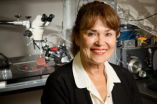(Press-News.org) Fort Davis, Texas — NASA's Kepler mission has found the first multi-planet solar system orbiting a binary star, characterized in large part by University of Texas at Austin astronomers using two telescopes at the university's McDonald Observatory in West Texas. The finding, which proves that whole planetary systems can form in a disk around a binary star, is published in the August 28 issue of the journal Science.
"It's Tatooine, right?" said McDonald Observatory astronomer Michael Endl. "But this was not shown in Star Wars," he said, referring to the periodic changes in the amount of daylight falling on a planet with two suns. Measurements of the star's orbits showed that daylight on the planets would vary by a large margin over the 7.4-Earth-day period as the two stars completed their mutual orbits, each moving closer to, then farther from, the planets (which are themselves moving).
The binary star in question is called Kepler-47. The primary star is about the same mass as the Sun, and its companion is an M-dwarf star one-third its size. The inner planet is three times the size of Earth and orbits the binary star every 49.5 days, while the outer planet is 4.6 times the size of Earth with an orbit of 303.2 days.
The outer planet is the first planet found to orbit a binary star within the "habitable zone," where liquid water could exist and thus create a home for life. However, the planet's size (about the same as Uranus) means that it is an icy giant, and not an abode for life. It's a tantalizing taste of discoveries waiting to be made.
The combination of observations from the NASA mission and McDonald Observatory allowed astronomers to understand the characteristics of Kepler-47's two stars and two planets.
The Kepler mission looks for minute dips in the amount of light coming from a star that might indicate a planet is passing in front of it, an event called a "transit." The space telescope is also adept at identifying eclipsing binary stars, in which two stars pass in front of each other as they orbit each other. In the case of Kepler-47, they found both stellar eclipses and planet transits in one system.
So Kepler astronomers Jerome Orosz (lead author on the study) and William Welsh of San Diego State University flagged the Kepler-47 system as worthy of follow up from the ground. They asked the McDonald Observatory Kepler team to work with them.
Endl studied the binary star with the 9.2-meter Hobby-Eberly Telescope (HET, one of the world's largest telescopes), as well as the 2.7-meter Harlan J. Smith Telescope at McDonald.
"The challenging thing is that this is a very faint star," Endl said, "about 6,000 times dimmer than can be seen with the naked eye."
He was taking spectra of the system — looking for characteristics in its light to indicate the motions of the primary star. (The secondary star is too faint to measure.) The McDonald observations enabled astronomers to calculate the mass of the primary star.
These values, along with the Kepler eclipse and transit timings, were plugged into a model that calculated the relative sizes of all the bodies involved, Endl said.
The Kepler team at McDonald Observatory also includes Bill Cochran (a co-Investigator of the Kepler mission), research scientist Phillip MacQueen, graduate students Paul Robertson and Eric Brugamyer, and recent graduate Caroline Caldwell.
"This is the type of research where McDonald Observatory really excels," Cochran said. "We have excellent scientific instruments on our telescopes, and the queue-scheduled operation of the HET allows us to obtain spectra at the optimal times when they will give us the best information about the stars."
INFORMATION:
Established in 1932, The University of Texas at Austin McDonald Observatory near Fort Davis, Texas, hosts multiple telescopes undertaking a wide range of astronomical research under the darkest night skies of any professional observatory in the continental United States. McDonald is home to the consortium-run Hobby- Eberly Telescope (a joint project of The University of Texas at Austin, The Pennsylvania State University, Ludwig-Maximilians-Universität München, and Georg-August-Universität Göttingen). An internationally known leader in astronomy education and outreach, McDonald Observatory is also pioneering the next generation of astronomical research as a founding partner of the Giant Magellan Telescope.
NASA Ames Research Center manages Kepler's ground system development, mission operations and science data analysis. NASA's Jet Propulsion Laboratory in Pasadena, Calif., managed Kepler mission development. Ball Aerospace and Technologies Corp. in Boulder, Colo., developed the Kepler flight system and supports mission operations with JPL for Atmospheric and Space Physics at the University of Colorado in Boulder. The Space Telescope Science Institute in Baltimore archives, hosts and distributes the Kepler science data. Kepler is NASA's 10th Discovery Mission and is funded by NASA's Science Mission Directorate at the agency's headquarters.
NASA, Texas astronomers find first multi-planet system around a binary star
2012-08-29
ELSE PRESS RELEASES FROM THIS DATE:
Why are there so many species of beetles and so few crocodiles?
2012-08-29
There are more than 400,000 species of beetles and only two species of the tuatara, a reptile cousin of snakes and lizards that lives in New Zealand. Crocodiles and alligators, while nearly 250 million years old, have diversified into only 23 species. Why evolution has produced "winners" — including mammals and many species of birds and fish — and "losers" is a major question in evolutionary biology.
Scientists have often posited that because some animal and plant lineages are much older than others, they have had more time to produce new species (the dearth of crocodiles ...
Space-warping white dwarfs produce gravitational waves
2012-08-29
Gravitational waves, much like the recently discovered Higgs boson, are notoriously difficult to observe. Scientists first detected these ripples in the fabric of space-time indirectly, using radio signals from a pulsar-neutron star binary system. The find, which required exquisitely accurate timing of the radio signals, garnered its discoverers a Nobel Prize. Now a team of astronomers has detected the same effect at optical wavelengths, in light from a pair of eclipsing white dwarf stars.
"This result marks one of the cleanest and strongest detections of the effect of ...
NASA watching Isaac's approach to US Gulf Coast
2012-08-29
VIDEO:
An animation of satellite observations from August 26-28, 2012 shows Tropical Storm Isaac moving past the Florida Keys and into the Gulf of Mexico, nearing landfall in the U.S. Gulf...
Click here for more information.
NASA satellites have been providing valuable data to forecasters at the National Hurricane Center watching the development and progression of powerful Tropical Storm Isaac as it heads for landfall.
The Moderate Resolution Imaging Spectroradiometer ...
Having to make quick decisions helps witnesses identify the bad guy in a lineup
2012-08-29
Eyewitness identification evidence is often persuasive in the courtroom and yet current eyewitness identification tests often fail to pick the culprit. Even worse, these tests sometimes result in wrongfully accusing innocent suspects. Now psychological scientists are proposing a radical alternative to the traditional police lineup that focuses on eyewitnesses' confidence judgments.
In a new article forthcoming in Psychological Science, a journal of the Association for Psychological Science, Neil Brewer of Flinders University and colleagues report a new type of lineup ...
Study finds gene that predicts happiness in women
2012-08-29
Tampa, FL (Aug. 28, 2012) -- A new study has found a gene that appears to make women happy, but it doesn't work for men. The finding may help explain why women are often happier than men, the research team said.
Scientists at the University of South Florida (USF), the National Institutes of Health (NIH), Columbia University and the New York State Psychiatric Institute reported that the low activity form of the gene monoamine oxidase A (MAOA) is associated with higher self-reported happiness in women. No such association was found in men.
The findings appear online ...
Can branding improve school lunches?
2012-08-29
A popular marketing ploy with junk foods and other indulgent table fare can be an equally effective tool for promoting healthier eating in school cafeterias.
"Nutritionists and school lunch planners can turn the tables on children's poor eating habits by adopting the same 'branding' tactic used by junk food marketers," said Brian Wansink, an expert on the subtle cues that affect people's eating habits and professor of marketing at the Dyson School of Applied Economics and Management at Cornell University.
Food marketers have associated particular foods with mascots, ...
The beat goes in the brain
2012-08-29
URBANA, Ill. — Like a melody that keeps playing in your head even after the music stops, researchers at the University of Illinois's Beckman Institute have shown that the beat goes on when it comes to the human visual system.
In an experiment designed to test their theory about a brain mechanism involved in visual processing, the researchers used periodic visual stimuli and electroencephalogram (EEG) recordings and found, one, that they could precisely time the brain's natural oscillations to future repetitions of the event, and, two, that the effect occurred even after ...
Not all lung cancer patients who could benefit from crizotinib are identified by FDA-approved test
2012-08-29
Break apart a couple worm-like chromosomes and they may reconnect with mismatched tips and tails – such is the case of the EML4-ALK fusion gene that creates 2-7 percent of lung cancers. Almost exactly a year ago, the FDA approved the drug crizotinib to treat these ALK+ lung cancer patients, who were likely never smokers. Informed doctors use the test called a FISH assay to check for the EML4-ALK fusion gene, and then if the test is positive, ALK+ patients benefit greatly from crizotinib.
A recent University of Colorado Cancer Center case study published in the Journal ...
Metabolism in the brain fluctuates with circadian rhythm
2012-08-29
CHAMPAIGN, lll. — The rhythm of life is driven by the cycles of day and night, and most organisms carry in their cells a common, (roughly) 24-hour beat. In animals, this rhythm emerges from a tiny brain structure called the suprachiasmatic nucleus (SCN) in the hypothalamus. Take it out of the brain and keep it alive in a lab dish and this "brain clock" will keep on ticking, ramping up or gearing down production of certain proteins at specific times of the day, day after day.
A new study reveals that the brain clock itself is driven, in part, by metabolism, the production ...
Mayo study: Exercise can help cancer patients, but few oncologists suggest it
2012-08-29
ROCHESTER, Minn. -- Numerous studies have shown the powerful effect that exercise can have on cancer care and recovery. For patients who have gone through breast or colon cancer treatment, regular exercise has been found to reduce recurrence of the disease by up to 50 percent. But many cancer patients are reluctant to exercise, and few discuss it with their oncologists, according to a Mayo Clinic study published in the Journal of Pain and Symptom Management.
"As doctors, we often tell patients that exercise is important, but to this point, nobody had studied what patients ...




